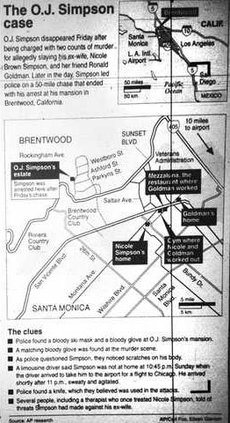Each week we’ll take a step back into the history of Great Bend through the eyes of reporters past. We’ll reacquaint you with what went into creating the Great Bend of today, and do our best to update you on what “the rest of the story” turned out to be.
On Friday, June 17, 1994, the attention of Americans was diverted from tough issues like child support enforcement, welfare reform, and nuclear weapons testing by China to watch a unique spectacle. Former NFL great O.J. Simpson starred in a real-life bizarre, slow motion chase along an Interstate in California when a warrant was issued for his arrest in the brutal murders of his former wife, Nicole Brown Simpson, and her boyfriend, Ronald Goldman on June 12.
“Millions watched the ordeal live on national television. In Los Angeles, thousands of people lined freeways and city streets and some cheered the former star running back for the NFL’s Buffalo Bills and University of Southern California.
“Clutching a family photo, Simpson was coaxed out of a white Ford Bronco and gave himself up just before 9 p.m.,” Associated Press writer Michael Fleeman wrote.
So began the national obsession with the Simpson trial which started months later, and continued for months until finally, Simpson was acquitted.
Today, Simpson is in jail, convicted on other charges. Simpson now resides at Lovestock Correctional Center in Nevada, serving up to 33 years after being convicted of kidnapping and armed robbery in 2008.
On Sunday, June 19, Tribune readers learned Simpson had been placed on suicide watch, in addition to a recap of all the weekend’s events.
Juvenile lock-up
During the week of June 19, 1994, former editor Chuck Smith reported on the expansion of the Youth Center at Larned, a juvenile detention facility.
“The spread of juvenile crime across the state of Kansas is taking its toll on state facilities, and one way it is being addressed is with enlargements at juvenile centers,” he wrote. At the time, Kansas had four youth centers, and all were running over capacity. YCAL ran from 75-80, but had a capacity only for 60 inmates. The number of staff members was expected to double. The expansion would be made possible by remodeling the Meyer Building, and was expected to be complete by September 1 of that year.
In 1995, House Bill 2090 separated the youth center from the Larned State Hospital. And in 2003, it was expanded again to a 152 bed facility separate from Larned State Hospital. The name was changed to Larned Juvenile Correctional Facility.
According to the website, “Specialized programs include substance abuse treatment, programming for youth residents who suffer from a mental illness or developmental delay, anger management, violent offender programs, and sex offender programs. Classes in independent living, parenting and vocation are also offered, and residents attend high school classes at Westside High School, USD # 495 (located within the facility). Medical, psychological and religious services are also provided to residents.”
Boyd dumping
The Barton County Commission discussed ways to solve the problem of illegal dumping west of Boyd. Closing the road was one possibility.
“When commissioners surveyed the site last week, they found furniture, appliances, building materials and more had been dumped into the ravine in that hilly pasture country.”
Around Kansas, public sentiment continued to turn against illegal dumps, until finally, a new law was created.
According to the Bureau of Waste Management website, House Bill 2860 went into effect July 1, 2000, allowing Kansas Department of Health and Environment to work with city and county governments to clean up illegal dumps throughout Kansas.
“KDHE is authorized to contribute 75% (up to a maximum of $10,000 per site) with the city or county being responsible for 25% of in-kind services.”
Still, illegal dumping is still a problem in the state. In February of 2014, Kansas City set up 19 surveillance cameras around the city to catch what turned out to be hundreds of illegal dumpers in the act, according to a story on KCTV 5 news. Illegal dumping continues to be an ongoing problem in rural areas too.
BAK
It was time for the 1994 Biking Across Kansas tour. Tribune was the beginning, and bikers would end their ride in Saturday in La Cygne.
Fast forward 20 years. Last week, the Tribune’s editor in chief, Dale Hogg, rode BAK. Despite nasty weather during the leg that brought bikers into Ellinwood this year, his spirits couldn’t be dampened. “Not only was it Bike Across Kansas, at times it was Party Across Kansas,” he was heard to say in the newsroom upon returning on Monday.
Out of the Morgue
Lock-ups, dumping crackdowns, and biking across the state in 1994





